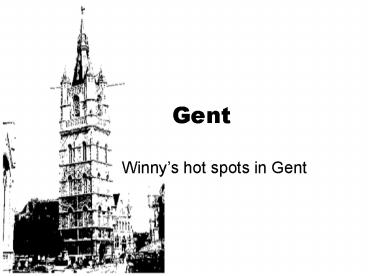Gent - PowerPoint PPT Presentation
1 / 10
Title:
Gent
Description:
From count's residence to cotton spinning mill, from small fortification with ... had 7 different crownings, adapted to the growing number of carillon clocks. ... – PowerPoint PPT presentation
Number of Views:88
Avg rating:3.0/5.0
Title: Gent
1
Gent
- Winnys hot spots in Gent
2
Castle of the Counts
- From count's residence to cotton spinning mill,
from small fortification with wooden buildings to
an imposing castle, from symbol of power to
tourist attraction. The Castle of the Counts has
had a lively history of building, decay and
revaluation. This enthralling story is told here
in six chapters. The latest excavations are
explained in 'digging into the past'.
3
The Graslei and Korenlei
- The numerous waterways passing through the city
centre all flow towards the former port at the
Graslei. - The elegant façades of the buildings on the
Graslei and the Korenlei represent different
architectural styles. However, together they make
up a unique view Ghent can truly be proud of.
Each façade reflects a period in history
reminding the visitor of the spirit of enterprise
and the busy commercial activities of the old
guilds.
4
Belfry
- The construction of the Ghent municipal tower,
symbol of the autonomy of the city, started in
1313. Repeatedly the works had to be suspended
because of wars and other tribulations. The
belfry was completed in 1380. During the course
of the centuries, the building had 7 different
crownings, adapted to the growing number of
carillon clocks.
5
Saint Bavos cathedral
- This splendid cathedral on St. Bavo's Square
combines various styles Romanesque style (the
crypt), high Gothic and late Gothic. Emperor
Charles V was christened in St. Bavo's Cathedral
in 1500. - The christening chapel contains the famous
masterpiece 'The Mystic Lamb'. This work of art
by the Van Eyck brothers from 1432 is considered
to be a high point in 15th century Flemish art -
an absolute must!
6
Patershol
- The Patershol, a quarter close to the Castle of
the Counts, is characterised by its well
conserved medieval structure as appears from the
street pattern and the small scale building
development. - Next to an impressive number of remarkable
façades and a number of valuable classified
buildings, the Patershol is also renowned for its
excellent restaurants.
7
The MIAT
- The MIAT (Museum of Industrial Archaeology and
Textile) is a unique museum that focuses mainly
on the fundamental technological changes in our
society during the last 250 years.In this old
cotton mill, the visitor is submerged in a story
of textiles and socio-cultural (r)evolutions
8
Toreken (former guildhall)
- The Toreken, formerly the tanners guildhall, was
built in Gothic style between 1450 and 1483. It
has a step-gable in Kammerstraat and a special
distinguishing feature is its staircase tower. - The ground floor, which is used for storing,
working, and trading, is rather austere. Most
remarkable of all is the guild hall ceiling on
the first floor with tie-beams resting on carved
corbels. The second floor and the attic are also
very impressive.
9
Groot Huis (Theatre)
- The Groot Huis (former Royal Dutch Theatre) was
designed by architect Edmond De Vigne and built
at the end of the 19th century. What stands out
on the facade is the large tympanum decorated in
multi-coloured mosaic. - The allegorical scene depicts Apollo and the
Muses. In the recesses, scenes from the major
Ghent drama society from the end of the 19th
century are on display. The theatre's interior is
shaped by neo-Renaissance and eclectic designs.
10
Mammelokker
- The small building adjacent to the belfry and
the cloth hall was erected in 1741 in Louis XV
style, to the design of David 't Kindt. It served
as the jailer's lodging and gave access to the
town jail, which was accommodated on the ground
floor from 1742 to 1902.

